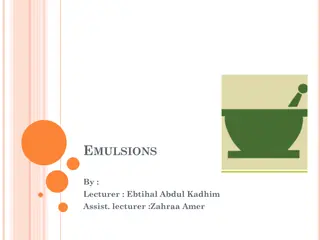Understanding Emulsions in Pharmaceuticals
Emulsions are dispersions where small liquid globules are distributed in an immiscible vehicle. While many pharmaceutical products are emulsions, some may fall into different categories. There are two main types of emulsions: oil dispersed in water (O/W) and water dispersed in oil (W/O). Factors aff
1 views • 33 slides
Understanding the Phase Rule in Physical Pharmacy: Two Component Systems and Equilibrium Phases
The Phase Rule is essential in determining the state of a system based on components and phases. This study explores two-component systems in physical pharmacy, illustrating miscibility behaviors and equilibrium phases through diagrams and explanations. Understanding binodal curves, tie lines, and t
0 views • 12 slides
Understanding Tie Lines in Ternary Systems
Ternary systems involve three components where partial miscibility can lead to phase separation. Adding alcohol to a benzene-water mixture can promote miscibility by acting as an intermediary solvent. By breaking cohesive bonds and increasing heat, the system can transition to a single phase. The pr
0 views • 15 slides
Understanding Analytical Chemistry: Solutions and Miscibility
Explore the fundamentals of solutions in analytical chemistry, including the types of solutions, role of solutes and solvents, and the concept of miscibility. Learn about the six types of solutions based on phases, the general rule of miscibility, and the solution process involving dissolution and c
0 views • 17 slides
Understanding Phase Rule and Components in Physical Pharmacy
Exploring the Phase Rule, components in physical pharmacy, and different types of systems with varying miscibility of components such as ethyl alcohol, water, and mercury. Learn about the binodal curve, tie line, and the impact of temperature and concentration on phase behavior in two-component syst
0 views • 12 slides
Understanding the Phase Rule and Components in Systems
The phase rule helps determine the minimum number of components needed to define a system's state. Components in equilibrium systems can be expressed as chemical formulas. Two-component systems can exhibit complete immiscibility, partial miscibility, or complete miscibility based on factors like con
0 views • 13 slides





